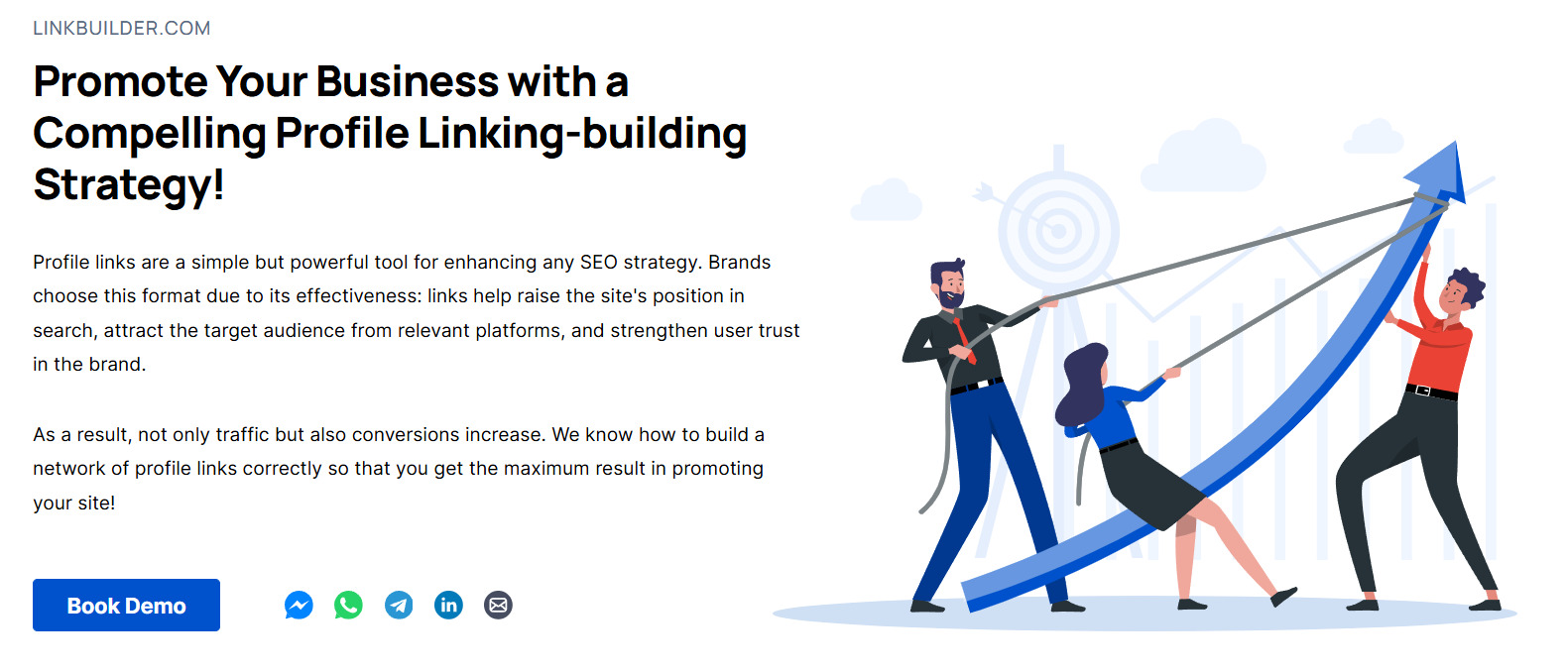The debate over the value of profile links for SEO continues to spark discussion in 2026. Some SEO experts consider them outdated, while others still achieve tangible results.
As usual, the truth lies in the middle: profile links remain effective in SEO, but only when approached strategically. Google’s algorithms have grown more sophisticated, and mass profile creation can now do more harm than good. However, a thoughtful presence on authoritative platforms can deliver significant profile links benefits.
In this article, you’ll discover how profile links affect SEO, which platforms yield the best results, and how to avoid common pitfalls. Whether you’re an experienced SEO professional or just starting out, this guide will help you make informed decisions and stay ahead of the competition.
What Are Profile Links?
What are profile links in the context of SEO? These are external links placed in user profiles on various online platforms that direct traffic to your website. Typically, these links appear in fields like “Website,” “About,” “Bio,” or other sections where platforms allow URLs.
Profile backlinks SEO refers to clickable links that pass a certain level of “weight” to your site. Unlike plain text mentions, they create a direct connection between the platform and your website, which search engines interpret as a signal of trust.
It’s critical to understand that in modern SEO, profile links are not just a way to mechanically boost the number of external links. They are elements that should seamlessly integrate into your broader strategy for building authority and brand recognition.
Where to Place Profile Links

Profile link building can be done across various types of platforms:
- Social Media: LinkedIn, Facebook, X, Instagram. These platforms allow links in bios and carry high authority in the eyes of search engines.
- Business Directories and Listings: Google Business Profile, Yelp, Yellow Pages. These are especially valuable for local SEO and validating a business’s existence.
- Professional Platforms: GitHub for developers, Dribbble for designers, Medium for writers, Behance for creative professionals.
- Forums and Communities: Reddit, Quora, niche-specific forums. Links can be added in responses to user questions.
- Freelance Platforms: Upwork, Fiverr, Freelancer, where you can include links to portfolios or company websites.
It’s important to distinguish between natural and artificial profile backlinks.
Natural Profiles:
- Created by real individuals or company representatives
- Include complete information (photos, bios, work experience)
- Show activity on the platform (posts, comments)
- Are limited in number but high in quality
- Hosted on platforms relevant to the website’s niche
Artificial Profiles:
- Created en masse, solely for link placement
- Contain minimal information
- Show no platform activity
- Often placed on irrelevant platforms
- Feature suspiciously similar descriptions or text
Modern Google algorithms effectively detect artificial profiles, making safe profile links a critical concern. Using low-quality, mass-created profiles can lead to site penalties.
When Profile Links Are Justified
Building profile backlinks can be effective in the following scenarios:
- Brand Strengthening: Establishing an official company presence on authoritative platforms.
- Link Profile Diversification: Profile links complement other link types, creating a more natural link profile.
- Early-Stage Promotion: For new websites, these links can serve as a first step toward building baseline authority.
- Personal Branding: For consultants, experts, and freelancers to establish professional credibility.
- Local Businesses: Profiles in local directories are essential for businesses with a physical presence.
When Profile Links Are Not Justified:
- Creating them en masse on irrelevant platforms
- Using barely filled or generic profiles
- Aiming solely for links without plans for active participation
- Relying on automated tools for mass profile creation
Why Profile Links Remain Relevant in SEO
Why do profile links, which some consider a relic of the past, remain relevant in SEO? To find the answer, we need to look back and see how the workings of search engines have changed.
History and Evolution: From Mass Profile Creation to Strategic Use
The profile backlinks importance has evolved significantly over the years. Let’s explore this transformation:
2005-2010: The Era of Mass Profile Creation
In the early days of SEO, profile links were low-hanging fruit. Optimizers created hundreds of profiles on forums, directories, and social networks, often using bots. Quantity trumped quality, and this approach worked.
2011-2015: The Era of Filters and Penalties
With the introduction of Google’s Penguin and Panda algorithms in 2011-2012, the landscape shifted. Search engines began identifying and penalizing sites with unnatural link profiles, and many faced manual penalties for low-quality profile backlinks.
2016-2020: The Era of Quality and Relevance
SEO professionals realized that profile SEO links needed to be high-quality and relevant. The focus shifted to creating robust profiles on authoritative platforms aligned with a site’s niche.
2021-2025: The Era of Context and Expertise
Profile links are effective only within a broader strategy for building authority. Search engines analyze not just the presence of a link but also the profile’s activity, the author’s expertise, and community engagement.
2026-?: The Era of Social Signals and Digital Authority
In 2026, the role of profile links in SEO will continue to evolve. As the importance of E-E-A-T – experience, expertise, authoritativeness, and trustworthiness – keeps growing, profile links from bot accounts and automated “satellites” will lose their value entirely. Instead, only profiles with real activity, trustworthy bios, meaningful contributions, and relevant content will hold true significance.
Profile Links in 2026: Trends and Changes
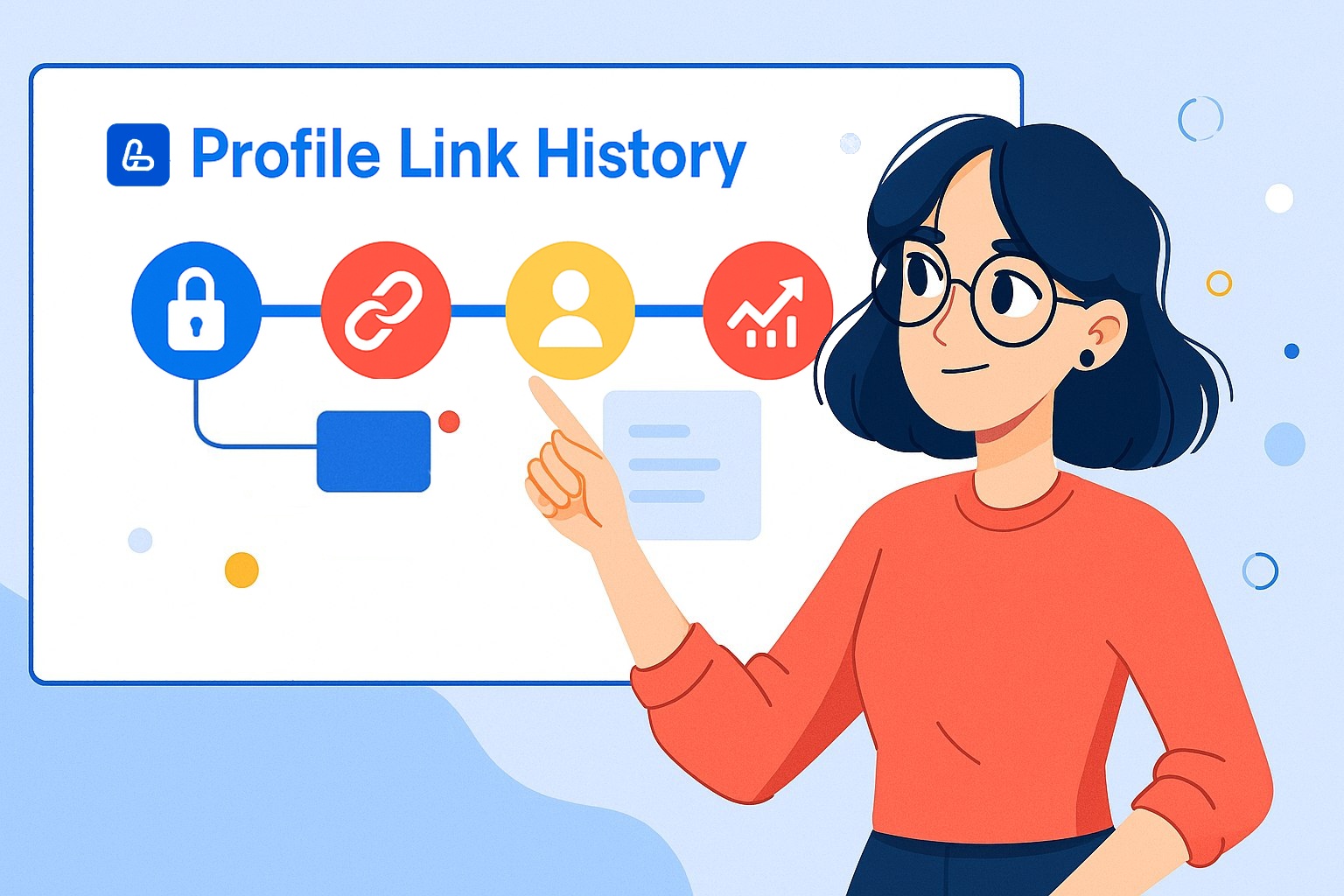
Today, profiles on social media, niche forums, and professional communities are powerful channels for driving traffic, strengthening brands, and influencing search engine rankings. However, the rules are constantly evolving. Where’s the line between effective profile link building and penalties in 2026? Let’s break it down.
From Quantity to Quality: Shifts in Link-Building Strategy
Over the past few years, the profile links strategy has undergone a fundamental transformation due to changes in algorithms:
- Google now treats nofollow links as “hints” rather than ignoring them entirely.
- Algorithms can detect “abandoned” profiles created solely for links.
- Artificial intelligence identifies patterns of mass profile creation.
- A “weighting” system evaluates the value of profile backlinks based on the platform’s reputation.
- New attributes like rel="sponsored" and rel="ugc" are interpreted differently by Google.
What’s Outdated:
- Chasing Quantity: Creating hundreds of empty profiles on questionable platforms for anchor links.
- Automation: Using scripts for mass registration and generic bio filling.
- Ignoring Relevance: A link to an auto repair site from a cooking portal profile was always ineffective, but now it can signal poor-quality link building.
What’s In:
- Focus on Traffic and Mentions: The goal is to create entry points for engaged audiences, not just place links.
- Reputation Management: Fully completed profiles with avatars, descriptions, and contact details should appear authentic, not like “link satellites.”
- Relevance and Authority: A single profile link from an active, respected professional community (e.g., GitHub for IT professionals or Behance for designers) is worth more than hundreds from abandoned forums.
How Profile Links Impact SEO in 2026
The profile backlinks impact on rankings persists because they remain a natural part of a brand’s online presence. However, Google has become far smarter at assessing their quality and authenticity. While they carry less direct weight than editorial links, their primary value lies in:
- Brand Recognition: Search engines aggregate brand mentions alongside profile links across the web, creating a “halo” of trust and popularity around your site.
- Targeted Traffic Channels: Search engines consider user behavior. A visitor clicking a profile link and spending time on your site sends positive behavioral signals.
- Local SEO: For location-based businesses, links from profiles in local communities, maps, and city groups are critical for ranking in local search results.
- Natural Diversity: Authentic brands and experts typically maintain a presence across platforms. A lack of profile links can appear unnatural.
- Social Signals: While Google doesn’t confirm a direct impact, social signals indirectly help assess a site’s authority.
In other words, profiles on authoritative platforms enhance E-E-A-T factors: Experience, Expertise, Authoritativeness, Trustworthiness. These are critical for modern SEO strategies.
What Profile Links Achieve
Profile links on platforms and social media are no longer just about link weight. They are a versatile tool addressing three key objectives:
- Building Trust and Digital Footprint: Search engines evaluate not just individual links but a brand or expert’s entire digital presence. Active profiles with quality profile backlinks on authoritative platforms – industry sites, social media, directories – act as social signals, showing that your business is active, recognized, and trusted by its community. This directly impacts user and algorithmic trust.
- Accelerating Indexing of New Content: Despite advancements in crawling, search engine bots still rely on signals to quickly discover new pages. Placing a link to a new article, product, or case study in an active profile creates such a signal, especially for young sites with low authority that might otherwise wait weeks for indexing.
- Brand Enhancement and Reputation Management: A well-crafted profile with clear positioning and a link to your site acts as a mini-landing page. It communicates your brand’s values, directs engaged users to key pages, and helps suppress unwanted mentions, creating a cohesive and controlled online reputation.
Best Practices for Profile Links
Profile link best practices in 2026 focus on maximizing benefits while minimizing risks. Here are safe and effective strategies:
- Choose High-Quality Platforms: Prioritize platforms with high Domain Rating (DR) and trust.
- Fully Complete Profiles: Include photos, detailed bios, work experience, education, and other relevant information.
- Stay Active: Post content, engage in discussions, and respond to questions on platforms where you have profiles.
- Vary Anchors: Use a mix of anchor text – brand names, URLs, keywords, and generic phrases.
- Gradual Growth: Create no more than 2-3 profiles per week, especially for new sites.
- Ensure Relevance: Select platforms aligned with your site’s niche.
- Manual Creation: Build profiles manually, focusing on unique, detailed content.
- Monitor and Maintain: Regularly check profiles, update information, and track their status with a profile link audit.
Benefits of Profile Links
Before diving into the practical aspects of working with profile links, let’s explore the profile links benefits they offer for SEO.
Benefits for Your Link Profile
Profile links provide several advantages:
- Natural Appearance: Search engines view profile links as more organic since they’re placed within the context of personal or corporate representation.
- Link Profile Diversity: Google values diverse link sources, and profile backlinks contribute to a more natural and varied link structure.
- Accessibility: Most platforms allow free profile creation.
- Branded Anchor Opportunities: Profiles often permit links with branded anchors, positively influencing how search engines perceive your site.
Boosting Trust in Your Site and Brand
Profile links serve as social proof, showcasing your brand’s active presence in professional environments. They build a digital footprint, as mentions across platforms strengthen your online presence and recognition. Profile SEO links directly impact your site’s trust level:
- Presence on authoritative platforms creates an impression of legitimacy.
- Links from profiles on niche-specific platforms signal broad industry recognition.
- Detailed profiles with company history and contact information enhance business transparency.
When users see your company on reputable platforms with fully completed profiles, it boosts trust in both your brand and website. This is especially crucial for new projects needing to quickly establish authority.
Authoritative Platforms for Profile Links
Profile links examples from authoritative platforms carry particular value. We’ll dive deeper into platforms later, but here are a few examples for different industries:
LinkedIn – Ideal for B2B businesses and professionals. Links from well-crafted profiles carry significant weight and build trust in professional circles.

Crunchbase – Perfect for startups and IT companies. A profile here signals serious intent and transparency, which search engines value.
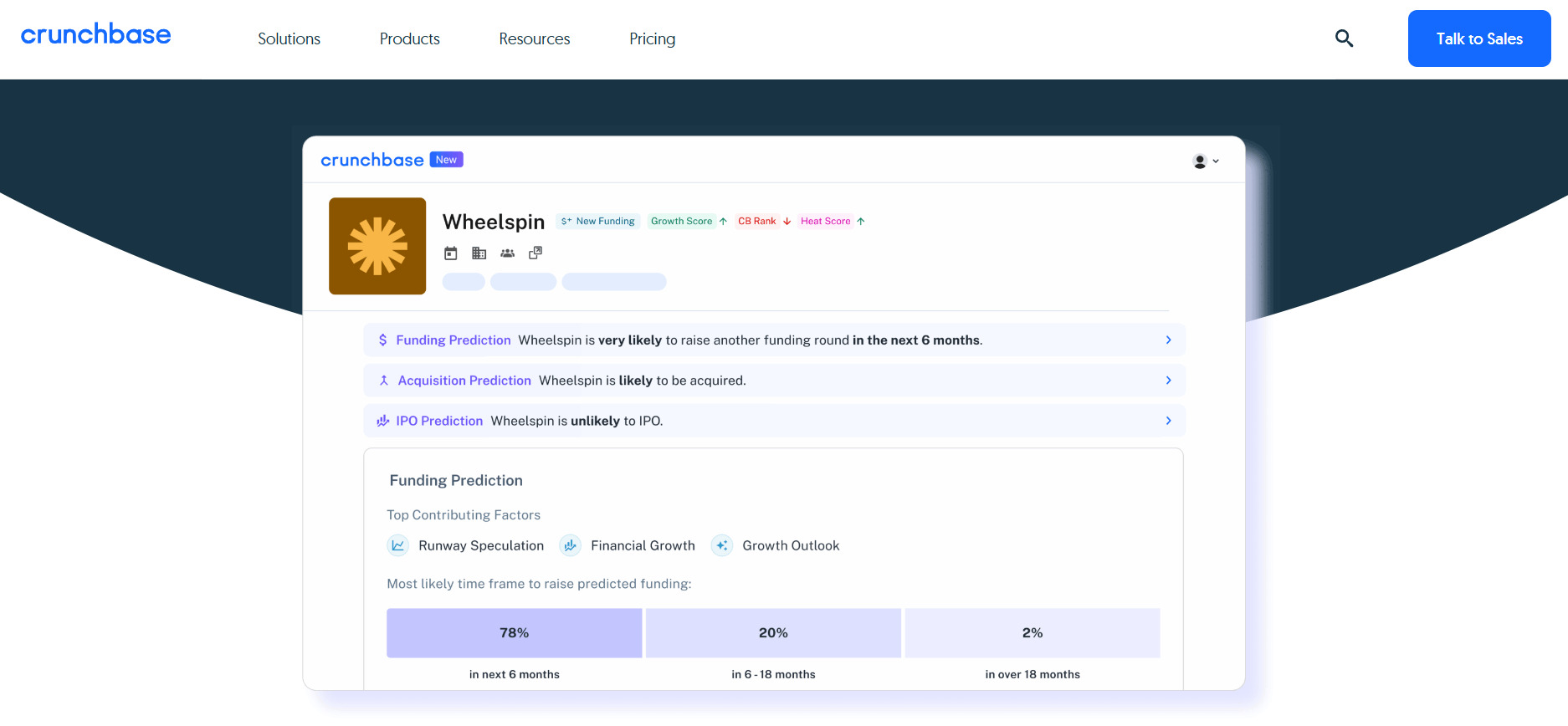
GitHub – Essential for IT professionals and tech companies. Links from GitHub profiles are strong indicators of expertise in the tech niche.
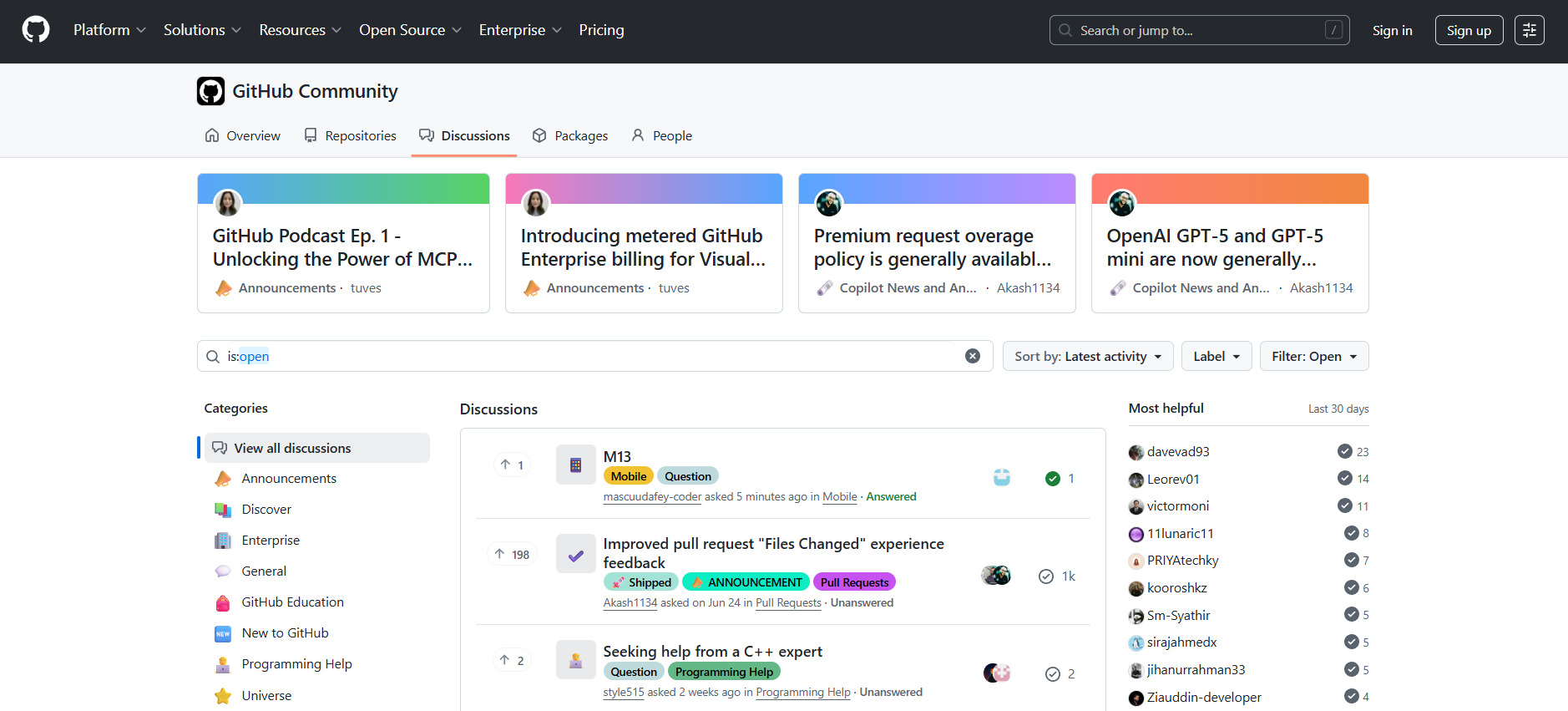
Behance and Dribbble – Key platforms for designers and creative professionals, where portfolio links carry high trust.
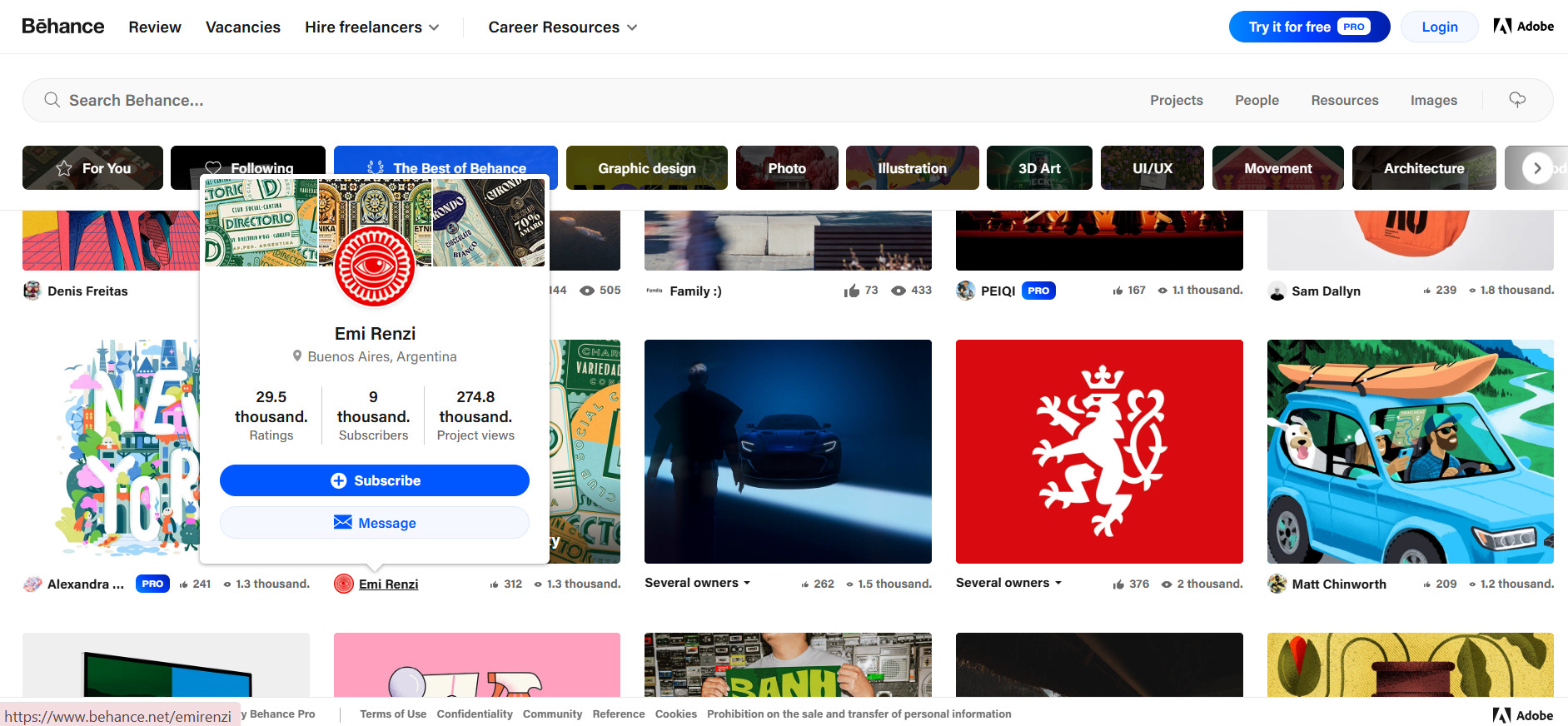
These platforms not only pass link weight but also drive targeted traffic to your site. Imagine an HR specialist finding your LinkedIn profile, visiting your site, and becoming a client. Such conversions are a bonus to the SEO benefits of profile links vs other backlinks.
Can Profile Links Harm SEO and How to Avoid It
While profile links offer many benefits, they can cause harm if created improperly. Let’s explore how to avoid negative consequences and ensure a safe profile links strategy.
How to Create Safe Profile Links
Safe profile links are characterized by the following:
- They are placed on thematically relevant platforms. For example, a web design site would benefit from a profile on Behance or Dribbble.
- Profiles are fully completed with real information, including a photo, experience description, and contact details.
- Platforms have a high Domain Rating and organic traffic.
- Links are added gradually, not all at once, to maintain a natural growth pace.
- A variety of anchors are used, with a focus on branded ones.
Safety also depends on the platform type. Profiles on platforms like Medium, Quora, or Product Hunt are generally safer than profile backlinks from low-quality business directories.
Profile Links and Their Safety for SEO
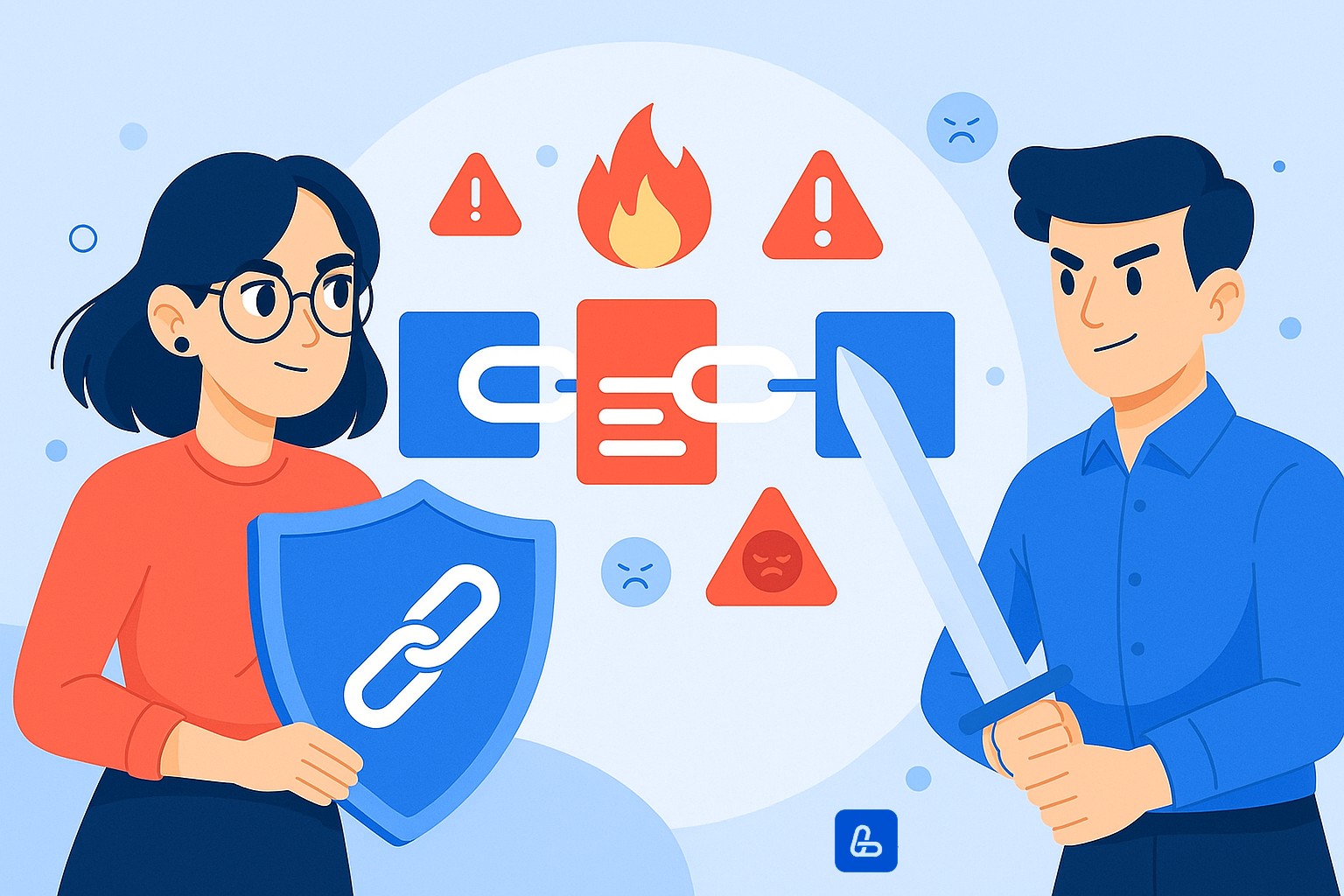
The topic of profile links and their safety for SEO raises many questions. The key to safety is compliance with platform rules. Links placed in designated fields (e.g., website or portfolio sections) typically align with policies and are less likely to be removed by moderators.
Risks arise only with mass placement on low-quality platforms or through automation. Here are the main risk factors:
- Scale and Speed. Creating hundreds of profiles in a short time raises red flags with Google. In 2026, algorithms are even smarter at detecting unnatural profile backlinks SEO patterns.
- Donor Quality. Links from “profile farms” or low-quality forums can lead to ranking penalties.
- Uniformity. Identical descriptions and anchors across all profiles look unnatural.
- Context of Placement. A link should blend organically into the profile, not appear as an obvious attempt at manipulation.
A safe approach emphasizes diversity and moderation. It’s better to have 20 high-quality profiles on authoritative platforms than 200 on questionable ones.
Common Beginner Mistakes
Beginners often make the following mistakes when working with profile backlinks:
- Mass profile registration using automated tools, which almost guarantees penalties.
- Neglecting profile completion. An empty profile with a single link looks spammy.
- Using exact-match commercial anchors across all profiles, e.g., “buy iPhone 15 cheap.”
- Choosing irrelevant platforms, like a credit-related site on a knitting forum.
- Ignoring platform rules, which can lead to profile bans.
- Using temporary email addresses for registration, making profiles vulnerable to deletion.
Avoid these errors to ensure how profile links affect SEO remains positive.
Donor Checklist: DR, Traffic, and Indexing
Before creating a profile, evaluate the platform using these criteria:
- Domain Rating (DR) – Ahrefs’ metric for domain authority. Higher is better.
- DR > 70: Excellent
- DR 40-70: Good
- DR 20-40: Acceptable
- DR < 20: Use cautiously
- Organic Traffic. Check via Ahrefs or SimilarWeb. Sites with no traffic have little value.
- Google Indexing. Ensure the site is properly indexed using the “site:” operator.
- Thematic Relevance. The platform should align with your site’s niche.
- Filters and Penalties. Check the site’s visibility history for sharp drops.
- Domain Age. Older domains typically carry more weight.
- Number of Outbound Links. Sites linking to thousands of resources dilute link value.
- Profile Moderation. Moderated platforms are usually higher quality.
This checklist ensures your profile links 2026 are placed on platforms where they’ll be most effective for rankings.
How to Use Profile Links Effectively
Using profile links requires balancing an assertive profile link building strategy with caution. Let’s explore optimal methods for different scenarios.
When to Use Profile Links and When to Avoid Them
How profile links affect SEO in 2026 depends on several factors. They are particularly effective in these cases:
- New Websites. Young sites need high-quality profile backlinks to quickly establish credibility with search engines.
- Local Businesses. Profiles in local directories and business listings boost local search visibility.
- After Domain Changes. Profile links help transfer authority to a new URL faster.
- Recovering from Penalties. Sites recovering from sanctions can use quality profile SEO links to regain rankings.
- Seasonal Businesses. Profile links placed before peak seasons can boost visibility quickly.
Profile links also enhance brand awareness, diversify profile backlinks importance, and support market expansion.
Avoid building profile backlinks in these situations:
- When your site already has link profile issues.
- If most of your links are already from profiles.
- When you lack resources to create high-quality profiles.
- If you can’t build links gradually and naturally.
Best Practices for Using Profile Links
Profile link best practices to avoid negative consequences:
- Maintain a moderate pace: 5–10 profiles per week for new sites, 15–20 for established ones.
- Prioritize quality over quantity. Ten profiles on authoritative platforms outweigh 50 on dubious ones.
- Diversify platform types: forums, social networks, business directories, and professional communities.
- Use a mix of domain zones: .com, .org, .net, and country-specific domains.
- Combine profile links vs other backlinks for a natural link profile.
- Create profiles under different personas (e.g., CEO, marketer, engineer) where appropriate.
- Monitor ranking changes after adding links to catch any negative impacts early.
- Regularly conduct a profile link audit to remove toxic links.
Profile Completion: Photo, Description, Anchors

Thorough profile completion is critical for do profile links help SEO:
Photo:
- Use professional photos or a high-quality company logo.
- Ensure size and proportions meet platform requirements.
- For personal profiles, use a neutral-background portrait.
- For brand profiles, use a high-resolution logo.
Description:
- Write unique descriptions for each profile.
- Highlight key competencies and achievements.
- Specify your geographic focus and specialization.
- Include trust-building facts.
- Aim for 150–200 characters minimum.
Anchors:
- Primarily use URL anchors (e.g., example.com) and branded anchors (e.g., Company X).
- Use commercial anchors sparingly and only where relevant.
- Add informative anchors like “Company X’s SEO blog.”
- Incorporate no-anchor links where possible.
Example of a strong profile description for a consulting firm:
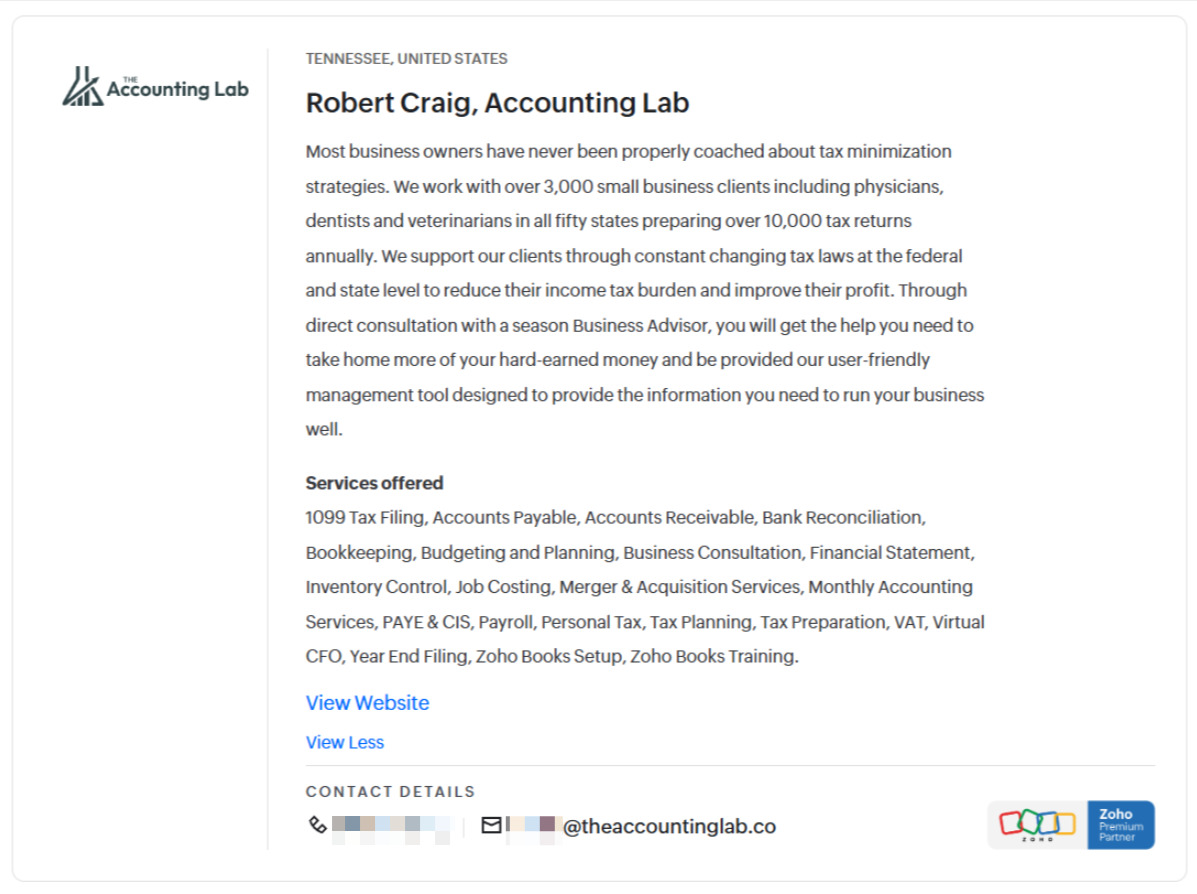
Balancing Branded and Commercial Anchors
A common mistake is overusing exact-match commercial anchors, which looks unnatural and may trigger search engine suspicion. A balanced approach is more effective:
- Branded Anchors (70%): Company name, personal brand, or site URL.
- Commercial Anchors (20%): Natural, diluted phrases like “SEO blog” or “our link-building services.”
- Generic/No-Anchor Mentions (10%): “my site,” “here,” or “learn more.”
This balance creates an organic profile that aligns with real user behavior, enhancing profile links benefits.
Tools for Checking Link Quality
Before placing a link, assess the platform’s quality. Links on spammy or irrelevant sites are ineffective or harmful. Use these tools:
- Ahrefs, Majestic SEO: Evaluate Trust Flow, Domain Rating, and outbound link counts. High TF with few outbound links is ideal.
- Serpstat, SimilarWeb: Analyze traffic and its trends. Declining metrics are a red flag.
- Google Search Console: Regularly check the “Links” report to track which profile links examples Google recognizes.
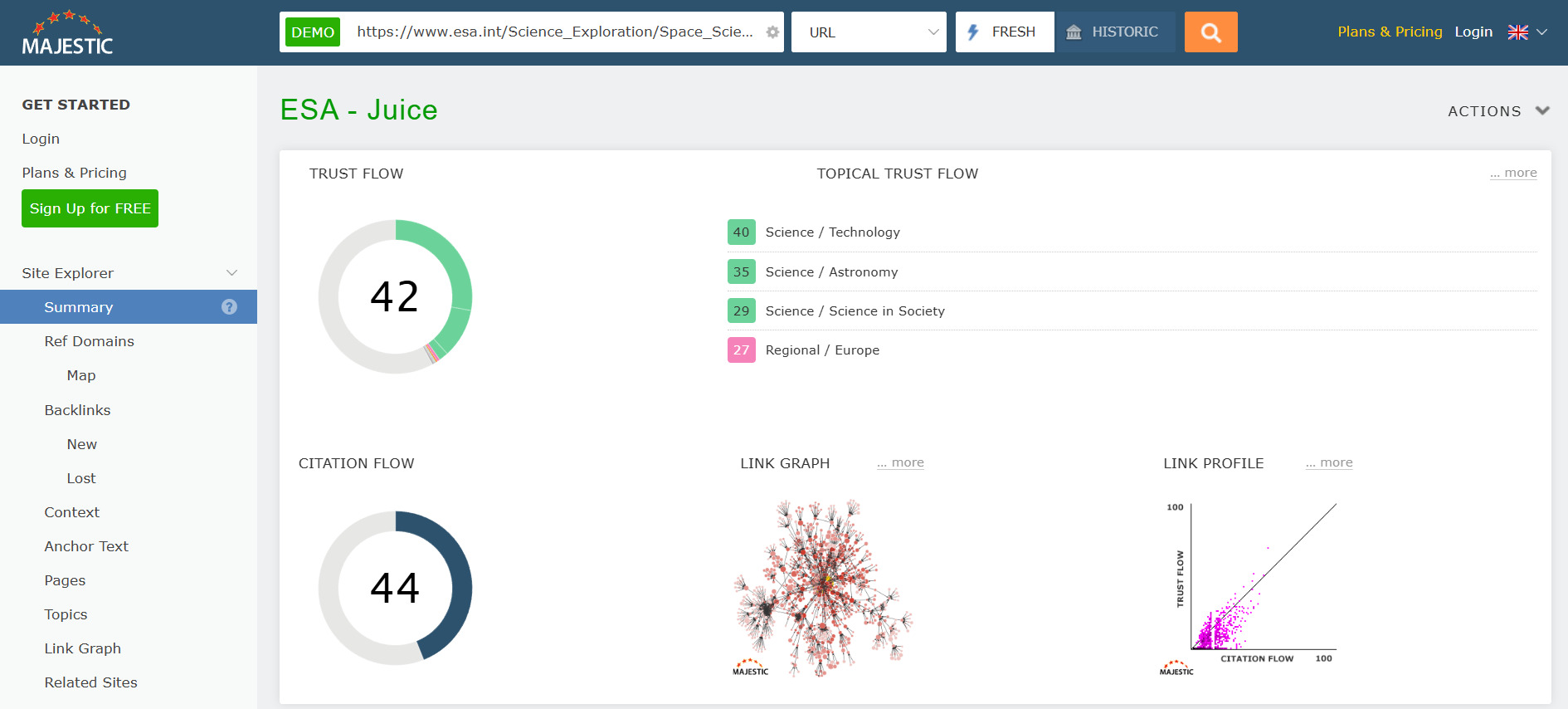
Measuring the Effectiveness of Profile Links
The profile backlinks impact on rankings isn’t always direct but can be tracked. Key metrics include:
- Traffic Growth:
- Referral Traffic: Use Google Analytics to track direct visits from profiles.
- Branded Traffic: Increased direct visits or brand searches in Google Search Console may reflect improved awareness.
- Visibility Improvement:
- Ranking Growth: Monitor positions of linked pages over time.
- Indexing Speed: Profile links can accelerate crawler visits, improving new page indexing.
- Link Profile Strength:
- Anchor List Diversification: Profile links balance your anchor profile naturally.
- Referring Domains: Growth in this metric in Google Search Console signals a broader digital footprint.
Where to Order Profile Links
Creating profile links is more than just adding URLs – it’s a long-term investment in your site’s growth, branding, and analytics. Manual selection and placement require significant time and expertise.
Trust the professionals! LinkBuilder.com experts will conduct a link audit, select relevant, authoritative platforms, and ensure natural, safe profile link placement. We handle everything manually – no automation or spam.
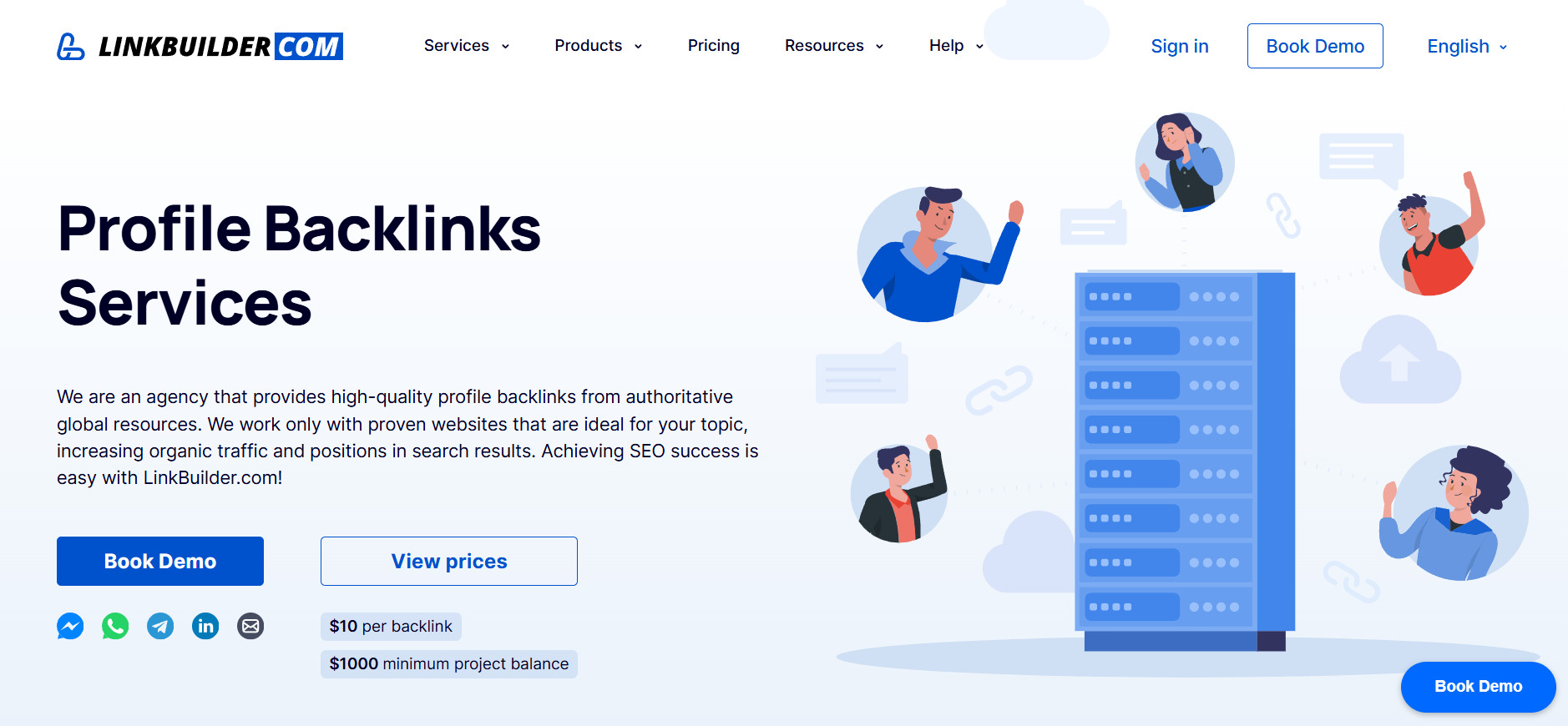
Our team will:
- Fully complete and verify profiles on key platforms.
- Place consistent links with UTM tags.
- Build a cohesive, trustworthy digital footprint for your brand.
LinkBuilder.com creates natural, safe link profiles for businesses of all sizes. We know how to leverage social networks, review platforms, and directories to drive traffic and boost rankings. Let us handle the routine so you can focus on growing your business.
Top 10 Platforms for Profile Links
What are profile links that deliver strong SEO value? Those placed on relevant, authoritative platforms. Here are the top 10 for 2026:
- LinkedIn – The largest professional network, ideal for B2B, networking, and boosting expert visibility. Links can be placed in company profiles, personal profiles, and posts.
- Reddit – A platform with countless niche communities (subreddits). Requires caution: links must be relevant and valuable to avoid bans or backlash.
- Behance (Adobe Portfolio) – A leading platform for creatives like designers, illustrators, and photographers. Linking from a portfolio showcases work and attracts clients.
- Crunchbase – An authoritative database for tech and startup companies. A detailed profile with a link builds trust with investors, partners, and clients.
- Thematic Business Directories (e.g., Yellow Pages, Yelp) – Modern equivalents of print directories, crucial for local businesses to attract regional clients and improve map visibility.
- GitHub – The go-to platform for IT professionals and developers. Companies can link from profiles, showcase open-source projects, and attract talent.
- Quora – A Q&A platform where users share expertise. Businesses and experts can demonstrate knowledge, attract audiences, and place relevant profile links.
- Thematic Forums and Niche Communities – Specialized platforms where your target audience engages (e.g., forums for car enthusiasts, parents, or travelers). Linking to relevant content in discussions is a strong strategy.
- Medium – A platform for publishing expert articles, offering quality links, expertise showcasing, and audience engagement.
- YouTube – Essential for video creators. Links in channel descriptions and video captions drive significant traffic for many businesses.
Comparing Platforms: Free vs. Paid Opportunities
Most platforms allow free link placement, while paid options offer enhanced visibility, additional link opportunities, or safer promotional formats.
| Platform | Free Link Placement | Paid Placement / Restrictions |
|---|---|---|
| Links allowed in posts, company/personal profile “Website” and “Links” sections. | Paid: Promote posts or Company Pages via LinkedIn Ads for greater reach and link traffic. | |
| Links permitted in posts/comments in relevant subreddits. |
Restrictions: Strict community rules. Frequent or irrelevant links lead to bans. Paid: Promoted Posts ensure safe ad placement. |
|
| Behance | Unlimited links in projects and profiles. | Free. Paid subscriptions enhance design tools, not link placement. |
| Crunchbase | Limited access in free plan. | Paid: Pro/Business plans allow unrestricted use, including link placement. |
| Thematic Directories/Review Sites (Yelp, Trustpilot, TripAdvisor) | Free company profiles with website links. | Paid: Paid plans offer priority in rankings, more links, or competitor ad removal. |
| GitHub | Links allowed in profile descriptions, repository READMEs. | Free. Paid plans enhance dev tools, not link rules. |
| Quora | Links allowed in answers/profiles if relevant and useful. |
Restrictions: Moderation for spam. Paid: Quora Ads promote answers with links. |
| Medium / Habr | Links allowed in article bodies if relevant. |
Restrictions: Habr often removes article links. Paid: Promote articles with links. |
| YouTube | Clickable links in channel/video descriptions. | Paid: YouTube Ads boost video visibility and link clicks. |
Free options are often sufficient for building a baseline value of profile links for SEO. Paid plans are worth considering for competitive advantages, advanced analytics, or targeted audience reach.
Tips for Working with Profile Links in 2026

In 2026, profile links remain a key part of a brand’s digital identity. They don’t always directly impact rankings but build trust with users and search engines, enhancing profile backlinks impact on rankings.
A strategic approach maximizes profile links benefits while minimizing risks. Here’s how to make the most of them.
Key principles for social media profile links strategy:
- Consistency and Branding. Use the same company name, logo, and URL across all profiles to boost recognition and simplify navigation.
- Prioritize Clickable Fields. Always fill website fields (e.g., on LinkedIn, Instagram). These links are clickable, typo-proof, and carry more weight than links in posts or bios.
- Use UTM Tags and Shortened Links. Add UTM tags to track traffic in Google Analytics. Use link shorteners (e.g., bit.ly) for aesthetics and convenience.
- Keep Links Current. Update links based on goals – point to new products, promotions, webinars, or landing pages to boost conversions.
Mini-Guides for Different Niches
For E-commerce
Priority Platforms:
- Trustpilot and other review platforms
- Industry-specific product directories
- Instagram, Pinterest, TikTok Shop (for visual products)
- LinkedIn (for B2B e-commerce)
Specific Tips:
Links on Instagram/Facebook/Telegram should lead to promotions, sales, or top products, not just the homepage. Temporarily update profile links for new collections or holiday sales, clearly stating the benefit in the bio, e.g., “Click the link → get 15% off.”
For SaaS Businesses
Priority Platforms:
- Product Hunt
- G2, Capterra
- GitHub
- Hacker News
- SaaS directories
- YouTube (channel description)
Specific Tips:
Links should lead to free trials, demo sign-ups, or webinars, not generic service pages. On LinkedIn Company Pages, use all link fields (main site, blog, docs, careers) to build trust.
For Local Businesses
Priority Platforms:
- Google Business Profile
- Local business associations
- Local forums and directories
Specific Tips:
Links should direct to online booking, order pages, or menus. Use clickable action buttons (“Book,” “Order,” “Contact”) integrated with your CRM where possible. Profile links should reinforce these actions.
Don’t want to navigate the complexities yourself? Book a free consultation to learn how LinkBuilder.com experts can craft a tailored profile links strategy.
